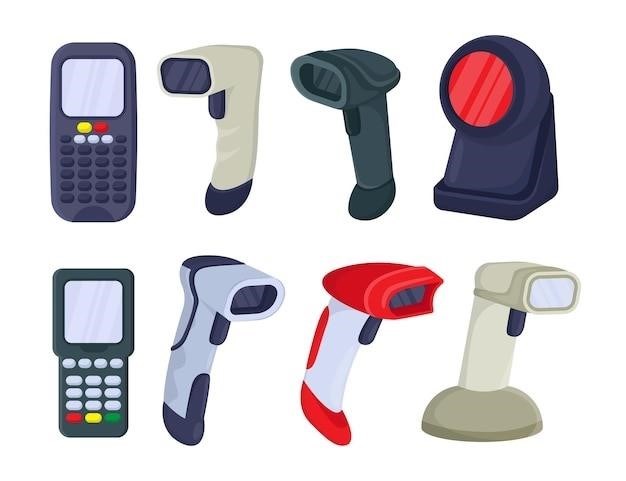Samsung RF4287HARS Owners Manual⁚ A Comprehensive Guide
This manual provides a complete guide to your Samsung RF4287HARS French Door Refrigerator. It covers features, installation, maintenance, troubleshooting, and safety information. Locate your manual online or via Samsung Support. Understand its innovative storage and energy-efficient design for optimal use.
Finding the Manual
Locating your Samsung RF4287HARS owner’s manual is straightforward. Begin by checking the original product packaging; often, the manual is included within the box. If it’s missing, Samsung’s official website is your next resource. Navigate to their support section, and use the model number “RF4287HARS” in their search bar. This should directly lead you to downloadable PDF versions of the user manual, often available in multiple languages, including English. Alternatively, you can contact Samsung customer support directly via phone or email. They can provide assistance in locating the manual or even send a physical copy if available. Searching online retailers such as Sears Parts Direct or similar websites specializing in appliance manuals may also yield results. Remember to verify the model number before downloading to ensure compatibility. Many online forums dedicated to appliances may also have user-uploaded copies of the manual; however, exercising caution and verifying authenticity is crucial.
Available Manual Types
For the Samsung RF4287HARS refrigerator, several manual types are typically available to assist users. The most common is the comprehensive User Manual, providing a detailed explanation of all features, functionalities, and operational procedures. This usually includes safety precautions, installation instructions, troubleshooting guides, and maintenance tips. A shorter, more concise Quick Start Guide is also frequently available. This guide focuses on the essential steps for setting up and using the refrigerator’s basic functions, providing a quick overview for immediate use. In addition to these user-focused documents, a Service Manual might be accessible, though often requiring specific access or technical expertise. This manual is intended for qualified technicians and includes in-depth technical specifications, diagrams, and repair procedures. While less common for direct consumer access, a separate installation guide might be provided, detailing the precise steps for connecting water lines and ensuring proper placement within the kitchen. Finally, depending on the retailer or source, you might find additional supplementary documents addressing specific features or troubleshooting specific issues.
Key Features of the RF4287HARS
The Samsung RF4287HARS boasts several key features designed for convenience and efficiency. Its French Door design offers ample storage space, cleverly organized to maximize usability. Independent cooling systems for the refrigerator and freezer compartments ensure optimal temperature control and prevent unwanted odor transfer between sections. The model often includes a built-in ice maker and water dispenser, simplifying access to chilled water and ice cubes. Many users appreciate the Surround Cooling technology, which aims for uniform cooling throughout the refrigerator, minimizing temperature fluctuations and extending food freshness. An internal water filter is commonly included to improve the taste and purity of dispensed water. Energy-efficient design features contribute to lower operating costs and a reduced environmental footprint. The user interface, typically involving digital controls, allows precise temperature adjustments and monitoring. Many models also incorporate features designed for ease of cleaning and maintenance, simplifying upkeep. Specific features may vary slightly depending on the exact model variant (e.g., RF4287HARS/XAA-00 vs. RF4287HARS/XAA-03), so consulting the accompanying manual is crucial for complete accuracy.
Installation Guide⁚ Initial Setup
Before commencing, carefully measure doorways, hallways, and the final location to ensure the refrigerator fits easily. The manual specifies dimensions; confirm sufficient clearance (minimum 3 inches from the wall for door swing). Position the refrigerator on a level, hard surface capable of supporting its weight (approximately 359 lbs/165 kg). Protect the floor using cardboard. Leveling is crucial for optimal door alignment and energy efficiency; adjust the front legs as needed. Check the manual for specific instructions on leveling and door adjustments. If door removal is necessary for transport, disconnect power beforehand, and carefully follow the steps outlined in the manual to avoid damage. Before connecting the water line (if applicable), ensure the water pressure meets the requirements specified in the manual (generally, sufficient pressure is needed for the ice maker). Use a water line installation kit to ensure a secure and leak-free connection. After installation, allow the refrigerator to stand upright for at least an hour before plugging it in to allow the refrigerant to settle. After plugging it in, allow several hours for the unit to cool down to the set temperature before loading food.
Water Line Connection and Ice Maker Setup
Connecting the water line is essential for ice maker functionality and water dispensing. Before starting, ensure your water pressure is adequate (20-125 psi is generally required; consult your manual for specifics). If using a reverse osmosis system, the pressure should be between 35 and 120 psi (241 and 827 kPa). Lower pressure may necessitate a booster pump. A water line installation kit (containing copper tubing and compression nuts) is recommended for a secure connection. Carefully follow the manual’s instructions for connecting the water line to the refrigerator’s inlet valve and your home’s water supply. Once connected, flush 1 gallon (approximately 6 minutes) of water through the filter to remove any impurities before use. Check for leaks at all connection points; tighten as needed. If leaks persist, immediately turn off the main water supply. The manual provides diagrams and detailed steps for a safe and proper connection. After connecting, ensure the water storage tank within the refrigerator is adequately filled by dispensing water until it flows freely. The ice maker should begin production after a short period; refer to the manual’s troubleshooting section if ice production does not commence as expected. Remember to replace the water filter regularly as indicated by the filter indicator light to maintain water quality and ice maker efficiency.
Temperature Control and Settings
The Samsung RF4287HARS offers precise temperature control for both the refrigerator and freezer compartments. The control panel typically features digital displays showing the current temperature settings for each compartment. Factory default settings are usually around 38°F (3°C) for the refrigerator and -2°F (-19°C) for the freezer, but these can be adjusted to your preferences. Use the control panel buttons to increase or decrease the temperature incrementally. The manual will detail the specific buttons and their functions. Remember that extreme temperature adjustments may take some time to fully reflect in the internal temperatures. It’s recommended to make small adjustments and monitor the temperature using a thermometer if necessary. The manual may also provide guidelines for ideal temperature ranges depending on the types of food stored. Pay attention to the indicator lights; the filter light will illuminate when it’s time to replace the water filter. If the temperature seems consistently too high or too low, refer to the troubleshooting section of the manual to identify potential issues. Regularly checking and adjusting the temperature settings ensures optimal food preservation and energy efficiency. Note that the display may turn off after a period of inactivity, but pressing any button will re-illuminate it. Always refer to the specific instructions within your owner’s manual for detailed information on temperature adjustment procedures.
Troubleshooting Common Issues
The Samsung RF4287HARS owner’s manual includes a troubleshooting section to help resolve common problems. If the refrigerator isn’t cooling properly, check the temperature settings, ensuring they’re appropriate for your needs and that the condenser coils aren’t obstructed by dust or debris. Regular cleaning of the coils is crucial for efficient cooling. If the ice maker isn’t functioning, verify the water supply is connected correctly and that the water pressure is sufficient (at least 20 psi). Low water pressure may necessitate a booster pump. A clogged water filter can also impede ice production; refer to the manual for filter replacement instructions and remember to flush the system afterward. Unusual noises might indicate a loose component; consult the manual for guidance on inspecting and tightening any loose parts. If the doors aren’t sealing properly, check the door alignment and gasket condition. A damaged gasket may need replacement. Problems with the water dispenser might stem from a clogged filter or air in the lines; the manual will offer detailed steps for addressing these issues. For more complex issues or those not covered in the manual, contact Samsung customer service or a qualified appliance repair technician. Don’t attempt internal repairs yourself unless explicitly instructed in the manual. Remember that safety precautions should always be followed when troubleshooting any appliance.
Maintenance and Filter Replacement
Regular maintenance is key to prolonging the lifespan of your Samsung RF4287HARS refrigerator. The owner’s manual details a cleaning schedule for both the interior and exterior. For the interior, periodically wipe down shelves, drawers, and walls with a mild detergent solution. Avoid harsh chemicals that could damage the finish. The exterior should be cleaned with a damp cloth. Pay close attention to the door seals, ensuring they remain clean and free of debris for optimal sealing. The manual provides specific instructions for cleaning the condenser coils, located at the back or bottom of the refrigerator. Dust buildup on these coils can significantly impact cooling efficiency, leading to higher energy consumption. Regular cleaning helps maintain optimal performance and energy savings. The water filter requires periodic replacement, as indicated by a light on the control panel. The manual details the steps for replacing the filter, including how to properly flush the system after installation to remove any trapped air. Failure to replace the filter on time could result in poor water quality and potential ice-maker malfunctions. Always refer to the manual for the correct filter type and replacement procedure. Ignoring filter replacement recommendations can compromise the quality of your drinking water and affect the overall performance of your refrigerator’s water dispensing system.
Safety Precautions and Warnings
Your Samsung RF4287HARS refrigerator manual emphasizes safety. Never attempt repairs unless you are qualified. Always unplug the refrigerator before cleaning or performing any maintenance. Ensure adequate ventilation around the appliance to prevent overheating. The manual cautions against overloading shelves, which could cause instability and potential injury. Children should be supervised near the refrigerator, especially around the doors and dispenser. Proper disposal of the refrigerator is crucial; consult your local waste management authority for guidelines. The manual stresses the importance of correct water line connection to prevent leaks and potential water damage. Regularly check for any signs of damage to the power cord and avoid using extension cords, as these could pose a fire hazard. Do not place flammable materials near the refrigerator. The manual warns about potential hazards related to improper installation, such as uneven surfaces that could cause tipping. The weight of a fully loaded refrigerator is significant; ensure the floor can support the load. The manual provides guidance on adjusting leveling legs to ensure stability. Always refer to the manual for detailed safety instructions. Improper use can lead to serious injury or property damage. Familiarize yourself with all safety warnings and follow them meticulously. Prioritize safety to ensure the long-term safe operation of your refrigerator. Your well-being and the protection of your property depend on adherence to these safety guidelines.
Specifications and Dimensions
The Samsung RF4287HARS owner’s manual details precise specifications and dimensions crucial for proper installation and placement. These dimensions, including height, width, and depth, are essential for ensuring the refrigerator fits in your designated space. The manual will specify clearance requirements for proper ventilation, both at the back and sides of the appliance. Understanding the weight of the refrigerator when fully loaded is critical to ensure floor stability. The manual might outline the electrical requirements, such as voltage and amperage, needed for safe operation. Capacity specifications, detailing the total storage volume of both the refrigerator and freezer compartments, are clearly stated to help you assess storage capabilities. The type of refrigerant used is also specified, contributing to environmental awareness and safe disposal procedures. The manual may mention the door-swing direction, aiding in planning optimal kitchen layout. Information on the type of compressor and its energy efficiency rating can be found in the specifications section. Details about the ice maker’s production capacity and water dispenser flow rate might be included, providing realistic expectations of performance. The insulation type and its efficiency contribute to the overall energy consumption. The manual emphasizes the importance of using the provided measurements and specifications to ensure a safe and effective installation process. Understanding these details will help you avoid installation problems and ensure optimal performance of your refrigerator.
Warranty Information
The Samsung RF4287HARS owner’s manual includes crucial warranty details. This section specifies the duration of the warranty coverage, typically outlining separate periods for parts and labor. It clearly defines what is covered under the warranty, such as defects in materials and workmanship. The manual might explain any exclusions, such as damage caused by misuse, accidents, or unauthorized repairs. It usually states the process for making a warranty claim, including contacting Samsung support or an authorized service center. Information on required proof of purchase, such as the original sales receipt or registration information, is typically included. The warranty might cover only the original purchaser, so transferability should be clarified. Specific parts that might have different warranty periods, such as the compressor or other major components, are often detailed. The manual usually provides contact information for Samsung customer service or the appropriate regional service center to assist with warranty claims. It might also list limitations of liability, specifying what Samsung is not responsible for under the warranty. The manual might mention the availability of extended warranty options, allowing consumers to purchase additional coverage beyond the initial warranty period. Understanding the terms and conditions of the warranty is essential to protect your investment and ensure proper servicing during the warranty period. Remember to retain your proof of purchase for warranty claim support.























